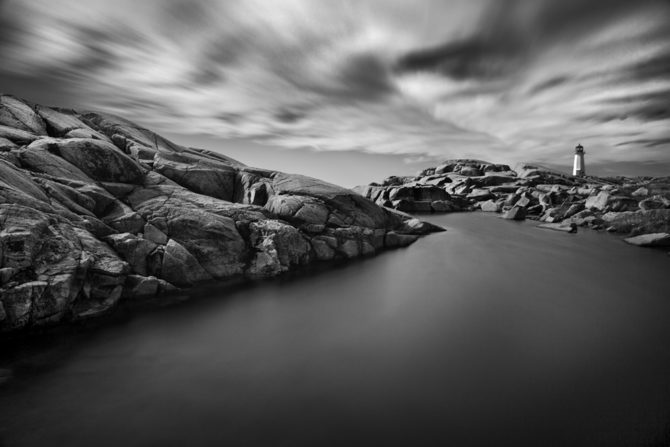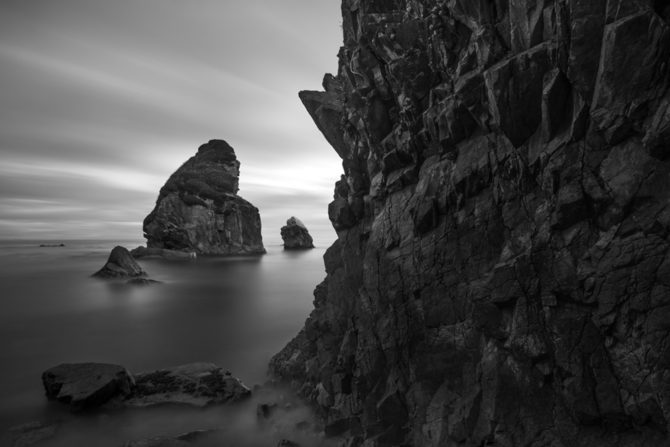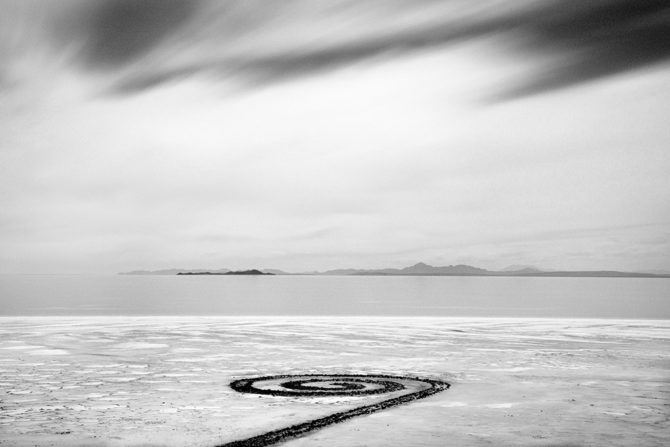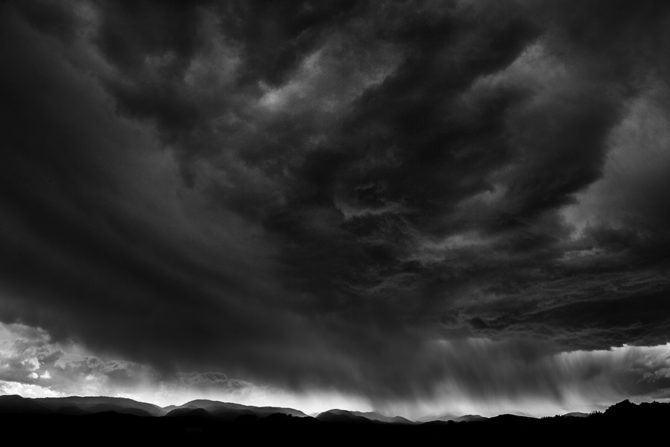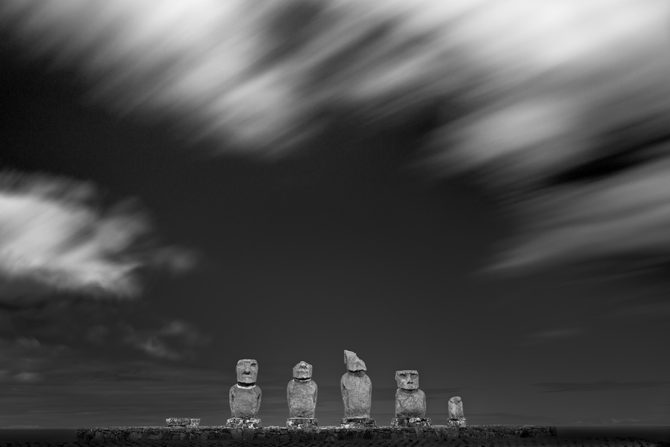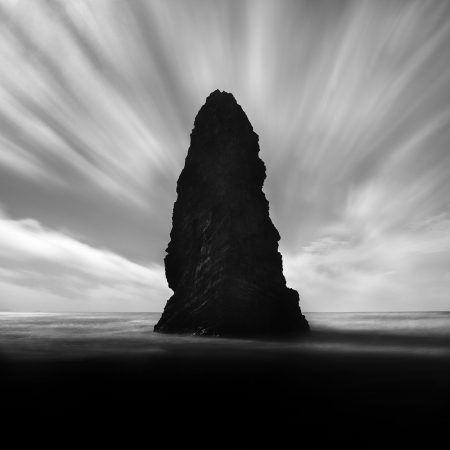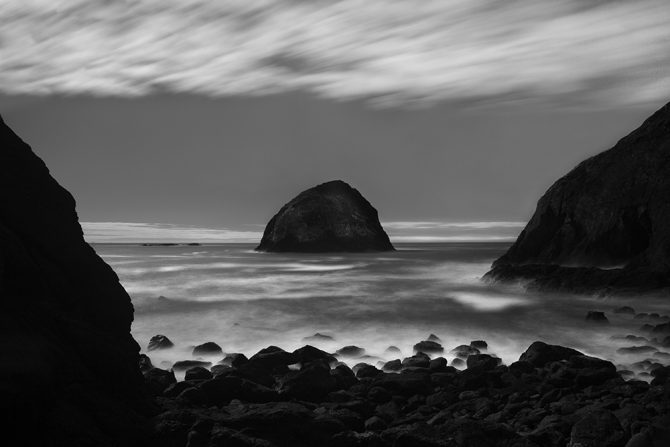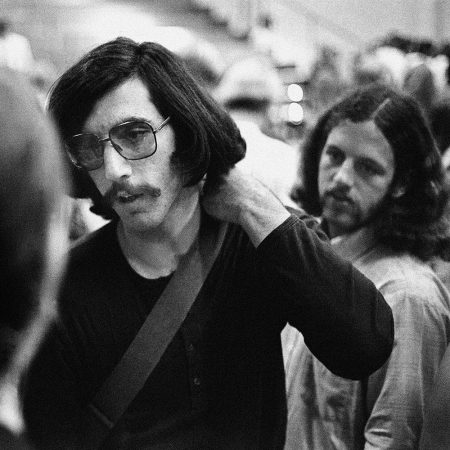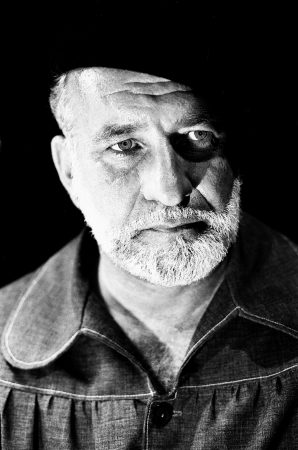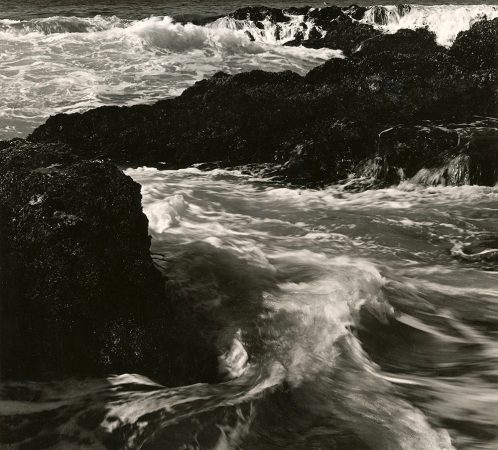Tag: vision
November 6, 2015
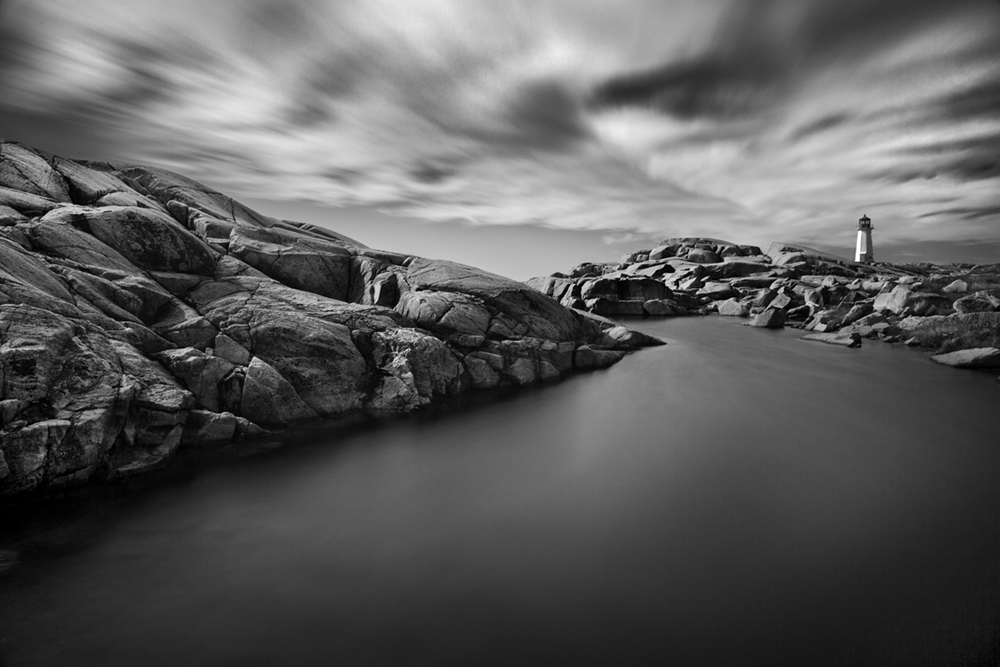
Peggy’s Cove, Nova Scotia
I’ve just driven 7000 miles in 22 days and during that time traveled through 22 states and 2 Canadian Provinces. That’s a lot of time in the car and it afforded a lot of thinking.
And what I’ve been thinking about is Passion and how it relates to Vision.
I noticed that as I drove through the incredibly beautiful autumn scenery of New England, I was not inspired to create. But when I came across water of any kind, and particularly along the coast, I found myself excited and creating.
Now one might initially attribute this to me being a black and white photographer in the middle of a color wonderland. But I don’t think that’s what it was. Fall colors can make for some amazing black and white images and I know that there are great images in those hills.
And yet here were thousands of photographers flocking to the area to shoot the beauty of the mountains and trees…and I’m only taking the occasional iPhone snapshot to send back to my family! Why?
My conclusion is that I just don’t feel a Passion for mountains and trees, but I do for water.
But “why” do certain environs inspire me while others do not? I don’t know and the “why” is not very important to me: what’s important is that I recognize the source of my Passion and then do something about it.
In the past I’ve tried to force projects that I didn’t have a Passion for: the projects languished, I had to force myself to work on them and I was not happy with the results. Not one of those projects were ever successful.
Never. Not one. Ever.
And so I’ve decided that with my limited time I will only focus on the places and things that excite me most, and for now that’s water and the coast.
I’ve long understood the role of Vision in creating work that I love, but now I’m beginning to appreciate the role of Passion as being nearly as important.
With Vision I can create unique images. With Passion comes an excitement that drives me.
And while I might use each one individually to some success, I now realize that my best work is created at the intersection of Vision and Passion.
Cole
October 9, 2015
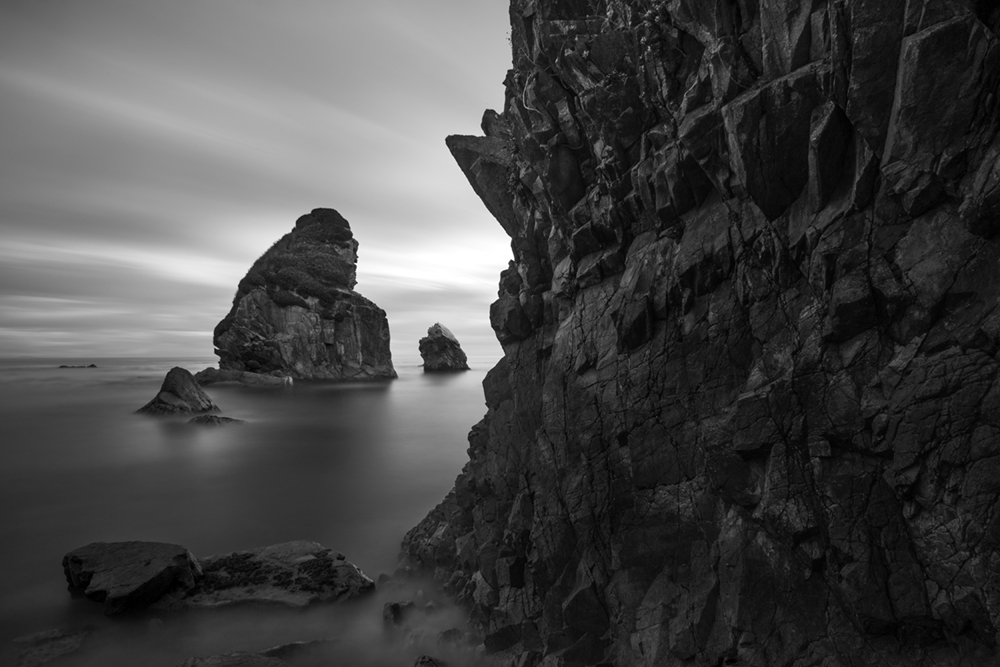
Last week I asked: “What’s Wrong With This Picture?”
Many of you guessed that I was up to something because I never list specifications and I never ask others about my work (it’s a Vision thing).
So what was the real point of the post? It was that the listing of technical specifications detracts from an image. They’re not just superfluous, but they actually detract from the viewing experience.
Listing specifications draws attention away from the only thing that matters (the image) and it furthers the folly that with the right equipment and processes…anyone could create this image.
- If only I had a full-frame camera…
- If only I had those “white” lenses professionals use…
- If only I had a tablet with 2048 levels of sensitivity…
- If only I had an 8-core processor…
- If only…
- If only..
- If only…
I loved what Stephen said in his comment: “An artist doesn’t praise or blame their tools, what only matters is their final work.”
There were other comments that brought up some important points that I’d like to reinforce:
1. Equipment and processes do not an image make. If I had to choose between the best equipment in the world but without my Vision…or a Kodak Brownie with my Vision…I’ll take the Brownie.
2. Never learn the rules of photography. But if you already know them, try to forget them and vow to never consider them when creating an image. Rules are an inadequate substitute for Vision.
3. Create for yourself. When you create an image you should only care what you think of it and not be concerned what others think. The best success is when you create an image that you truly love.
4. There is no right/wrong or good/bad when it comes to art. There is only what you like and don’t like. Please don’t be fooled into thinking that if more people like an image, that it’s a better image. The only thing it means is that more people like the image.
5. Never ask others about your images. Don’t you know what you want? Haven’t you discovered your own Vision? If not, then listening to another’s opinion will not help you find it, but will actually harm the process.
6. Don’t give other people advice about their images, even if they ask. Why not? Because it’s their image and what you think or would do with it is unimportant! (sorry to be so blunt)
When people ask me what I would do with their image, I say: It doesn’t matter what I would do, what is your Vision for it? If I kept telling you what I would do and you kept following my advice, it wouldn’t take long before your images would start to look like mine! (which is not a good thing)
7. The creator gets the final word. When I showed this image to my wife, the first thing she said was: “I like it but you should get rid of some of that rock wall.”
My response was: “No, this is how I see it.”
And unlike most things in marriage, I get the final word when it comes to my images!
While the original point I wanted to make with this blog post was that the listing of specifications is not a good idea, I think the more interesting discussion has been centered around Vision. And as you might have noticed, I am fixated on Vision.
Why? Because finding your Vision changes everything. It gives you the confidence to create what you want without the need for validation or the fear of criticism.
Vision changes the image and it changes the image maker.
Cole
July 24, 2015
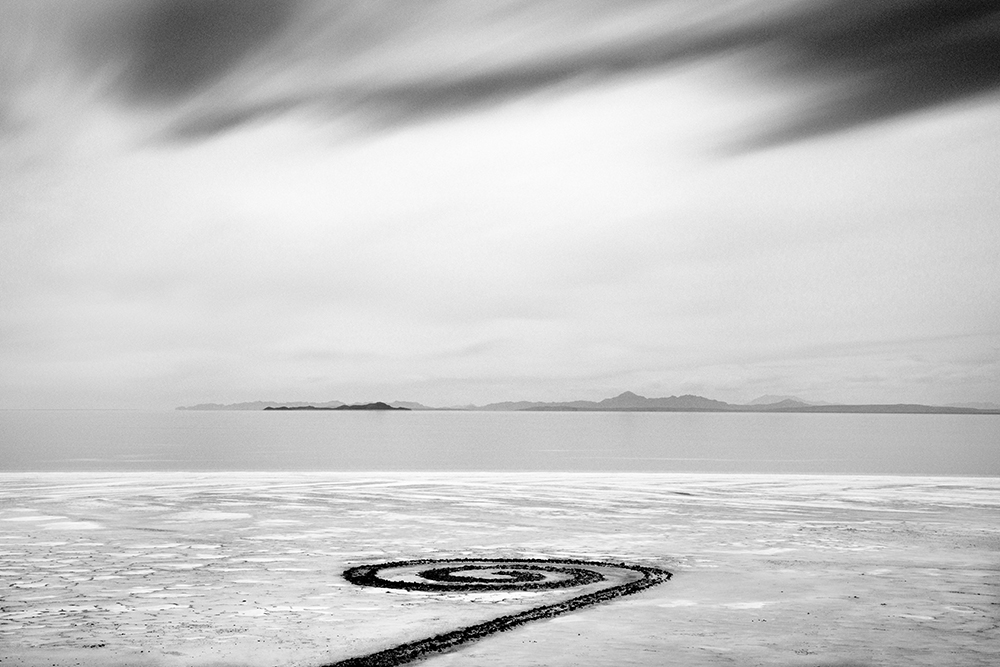
Spiral Jetty
Sometimes it seems that everyone is either an expert or a critic! Show your work to 10 people and you may well end up with 10 different opinions about your image. Why? Because everyone has an opinion.
So who should you listen to when it comes to your images? Family, friends, art experts, gallery owners, curators, MFA’s, other successful photographers? Who?
My suggestion is that you ignore all criticism, praise and advice and listen only to yourself. Why? Because other people’s comments about your image reflects their tastes, their ideas and their Vision. So no matter how well intentioned or how much of an “expert” they are, their advice is going to miss the mark when it comes to your Vision.
We all know how damaging harsh criticism can be; it can discourage, demotivate and cause you to doubt your potential. But even constructive criticism delivered in a kind and gentle way can mislead you and take you off track. That’s because others don’t know your Vision of the image, only you know that.
I was once told that I should not center “The Angel Gabriel.” At first this advice caused me to doubt my Vision and I actually tried to re-crop the image off center. It was a disaster because that was not how I saw the image. Right or wrong, for better or for worse, centered was the way I see Gabriel.

Strangely enough, I also find that praise can be disruptive to Vision. Praise sounds so sweet and we so want to believe it, but it can take us off track. There are many images that I’ve pursued but did not love simply because they generated praise. Praise is addictive and hard to ignore, but you must for the same reasons you should ignore criticism.
There was a time in my photographic life that I would ask people what they thought about my work. Why? Because I didn’t know where I was going and I mistakenly thought I could find the answers by asking others. I could not.
There’s an infinite number of voices out there and even if you had the time to listen to all of them, that would not help you find your Vision. That can only come from a great deal of hard work and solitary introspection. There is no other way.
So how do I view criticism, praise and advice? I try to be appreciative of the person’s sincere intentions but take their advice with a grain of salt and do my best to not let it sway my own opinion of my work (for good or for bad). Only I know my Vision and how closely I hit or miss the mark, and for that reason I believe that my opinion is the only one that matters.
When I see people asking for advice on their images, it suggests to me that they may not have found their Vision. And when you have not found your Vision, you are uncertain and need advice and reassurance from others.
Find your Vision and ignore criticism, praise and advice.
Cole
P.S. If you need help finding your Vision, here is the story of how I went about finding mine.
May 28, 2015
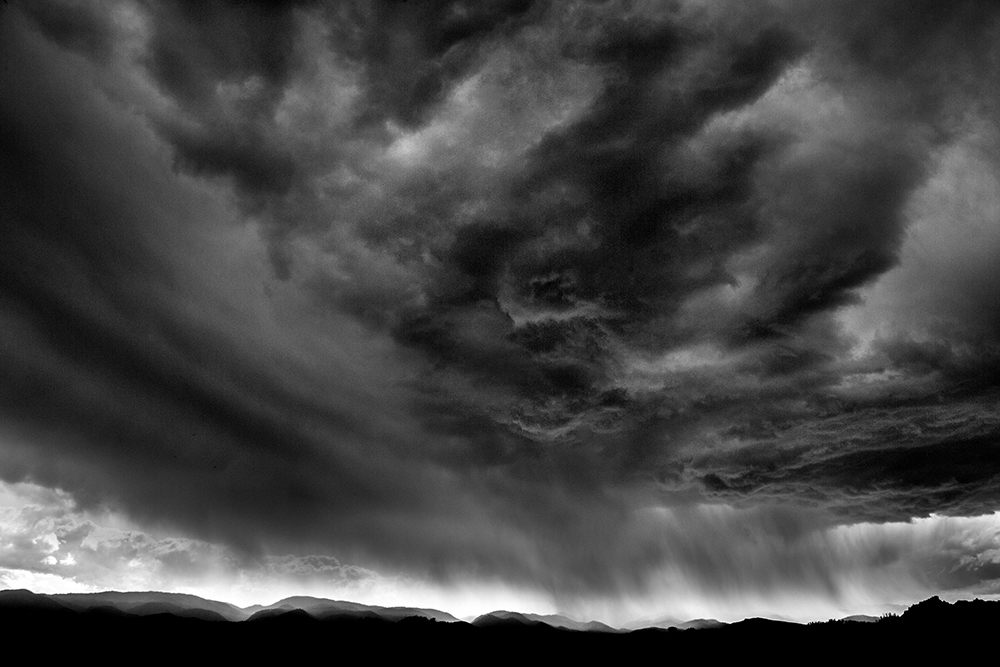
Storm Cloud, 2015
.
I have been accused of being arrogant for suggesting that the source of my Vision lies within myself and is not dependent upon the outside world or those who have gone before me.
I don’t believe this to be an arrogant idea. But here are some additional thoughts that may convince the unconvinced that I am in fact, arrogant.
.
Look inward.
Everything you need is already there.
Discover your Vision.
See for yourself.
.
We are all creative as children.
But then we learn how to seek approval.
And something atrophies and almost dies.
We forget how to please ourselves.
.
There is a difference between Vision and Inspiration.
Inspiration comes from without, Vision comes from within.
A person can only do so much with Inspiration.
Inspiration without Vision is an unproductive effort.
.
Look inward.
Ignore what others are doing.
Do what you feel inspired to do.
Create work that you love.
.
Art is very selfish.
Or at least it should be.
If you are creating for others,
then you are not creating your best work.
.
Do not compare your work to other’s.
Judge your art only by how you feel about it.
Create art that you are proud of.
Create art that you love.
.
Look inward.
You harbor that secret ingredient.
The secret to success.
Your Vision.
.
.
May 8, 2015
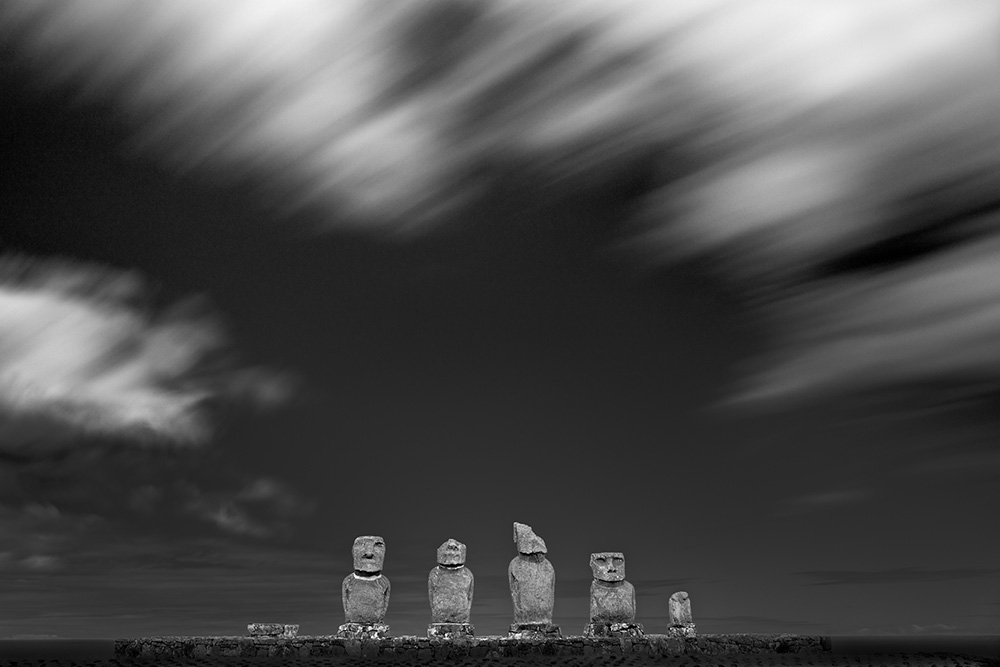
When I photograph, I do not seek to create images that are “different” from everyone else’s, I don’t calculate how to create unique images and I don’t research what others are doing and then react.
Different is not my goal.
Instead, my objective is to produce work that comes from my Vision and that is honest and original to me.

My work is all that I focus on and have control over. As my mother used to say: what others are doing is none of your business!
When I went to Easter Island the only photographs that I had ever seen were the 1950’s documentary images contained in Thor Heyerdahl’s book “Aku Aku.” I never looked at anyone else’s images for two reasons; first I didn’t want to subconsciously copy someone else and secondly I didn’t want to consciously try to be different from someone else.
My goal, as much as it was humanly possible, was to work in a creative vacuum. I wanted to see the Moai through my Vision and find my own Passion.
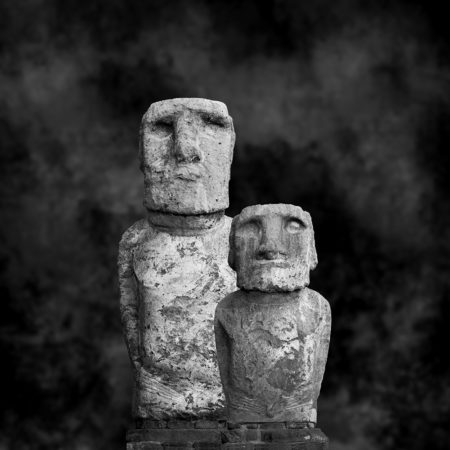
Are my Easter Island images unique? I may never know the answer to that as long as I practice Photographic Celibacy and do not look at other photographer’s work.
And to tell you the truth, I don’t want to know. I love my images and am content with the knowledge that they were created honestly through my Vision.
Cole
April 24, 2015
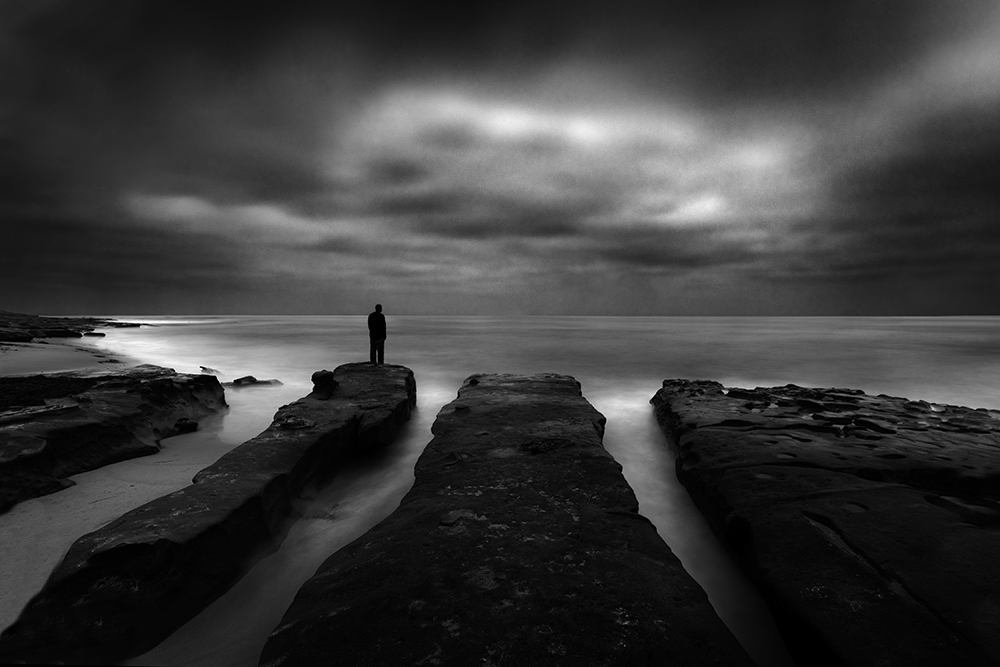
Last week someone asked if I was flattered when people copied my work. I said no, but that I wasn’t offended either.
What I actually feel is a bit of sadness. I’d rather see that person putting their energies into finding and following their Vision rather than walking where I have already walked.
Now these are friends and well-wishers who send me these imitations and so I am sincerely touched by the kind gesture. Sometimes they send a Lone Man or a Harbinger and sometimes it’s an Old Car Interior.
But honestly, I’d prefer they sent me something that they had created from their own Vision.
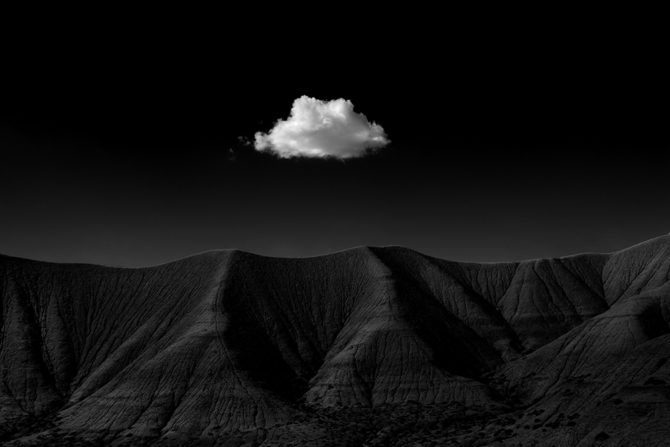
I very well understand imitation because I’ve copied other artists too, sometimes unconsciously and unfortunately sometimes consciously. For years I tried to copy Ansel’s work, and not just his look. Once I went to Yosemite and tried to recreate specific images of his!
I look back now and see how silly that was. Was my goal in life to be known as the world’s best Ansel Adams copycat?
Someone once wisely said to me: “Ansel’s already done Ansel and you’re not going to do him any better.” It’s true.
I know that many believe that imitation is a part of the learning process. I have many photography students contact me to say that their assignment is to copy one of my images.
I must say that I strongly disagree with this approach. I believe that their time would be much better spent finding their own Vision, and that imitation actually retards their personal Vision progress.
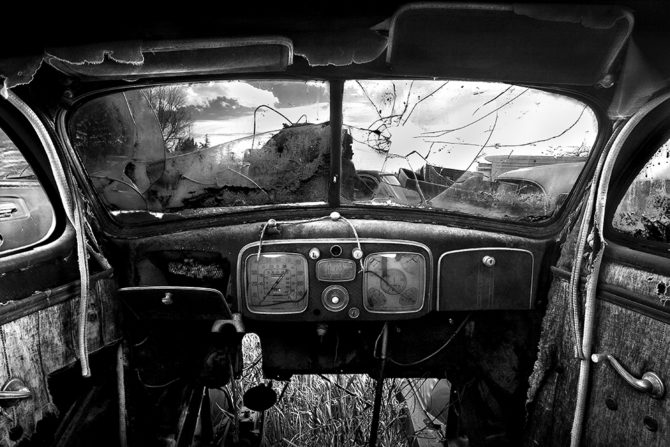
Colefucius says: They who walk in another’s footsteps, never finds their own path.
Is imitation is the sincerest form of flattery? I don’t think so.
Cole
March 20, 2015
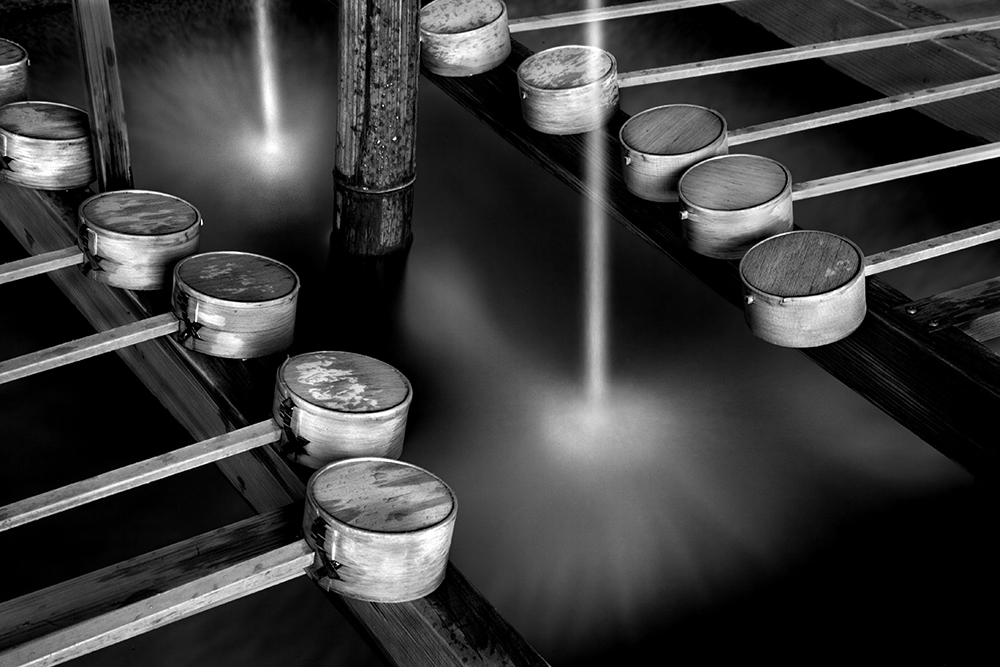
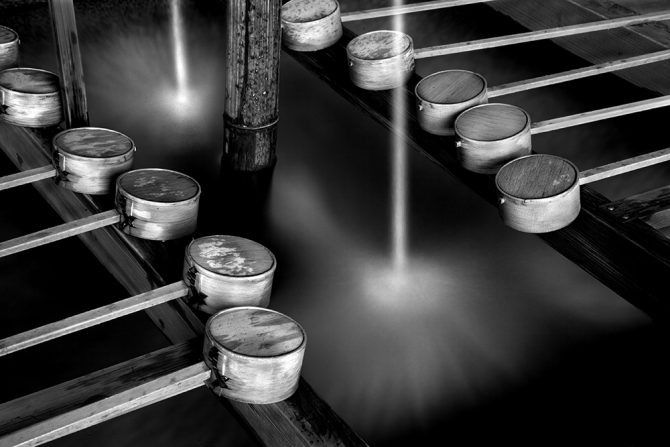
People write to me about their projects and say such things as:
I just cannot get motivated…
I’m in a slump…
My project is on hold…
I haven’t shot anything in a while…
I don’t know what’s wrong…
I need to get back to it…
I just can’t seem to finish it…
My rule of thumb is: If I am not energized and excited about my project, then it’s time for me to:
CHOOSE A NEW PROJECT
For me, a successful project must have two ingredients: Vision and Passion. If I don’t feel these I know the project is doomed, it will be a chore to work on and that lack of passion will be felt by the viewer.
Many feel that the key to a successful project is to have a unique subject, an exotic location or an interesting technique. And while those qualities may help, only Vision and Passion can ensure success.
When you have the right project, you cannot wait to get home to work on it. The right project has you getting up early and skipping meals. When you have the right project you find yourself working long hours and wishing there were more.
And most importantly; when you have a Vision and Passion for your project, that energy and conviction will be felt through your images.
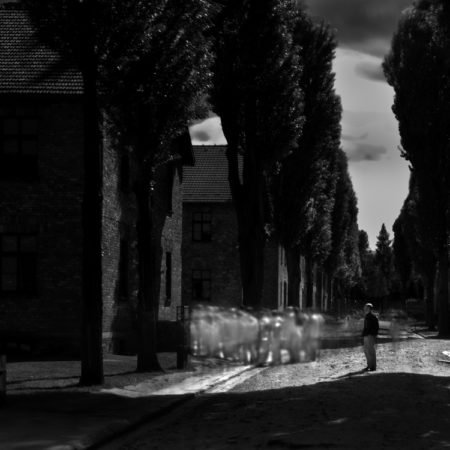
After I created the Auschwitz images many people suggested I apply the ghost theme to other locations. The idea sounded logical: the Auschwitz series had been well received and so why not leverage that popularity by using the same approach at other locations?
So I started to work on “The Ghosts of Great Britain” where I created ghosts at English castles. But the project fell flat because the images were not compelling and it all felt gimmicky.
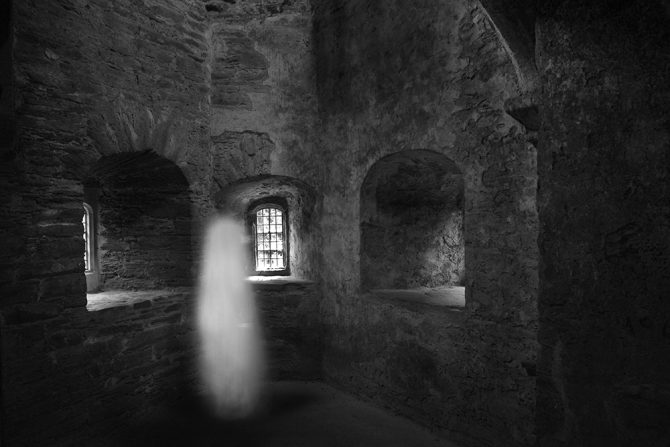
So what went wrong? The project lacked Passion.
At Auschwitz I felt inspired to create those images and I had a Vision for the project. I gave no thought as to how the series would be received and in fact I didn’t care!
But “The Ghosts of Great Britain” was completely contrived and calculated to be popular. I did not feel that same Vision or Passion for the project and it failed. I scrapped the series and only kept the one image above.
This was a great lesson for me and a mistake that I will never make again.
Many people ask where I get my ideas from and I tell them that every time that I have an idea, I write it down. And then I reveal that I’ve never once used any of those ideas! Every successful project that I’ve pursued has come to me spontaneously, unexpectedly and as a sudden burst of inspiration.
And then they ask: But what happens if you don’t have a project that excites and inspires you?
And I reply: Then I wait until I do.
Cole
P.S. I’ve mentioned “successful project” a few times now and I want to explain what I mean by that. I do not consider a project successful because it wins awards, is published, is exhibited or sells.
Success for me is creating a series that I love and am proud of, and that is the only kind of success that matters.
November 29, 2014
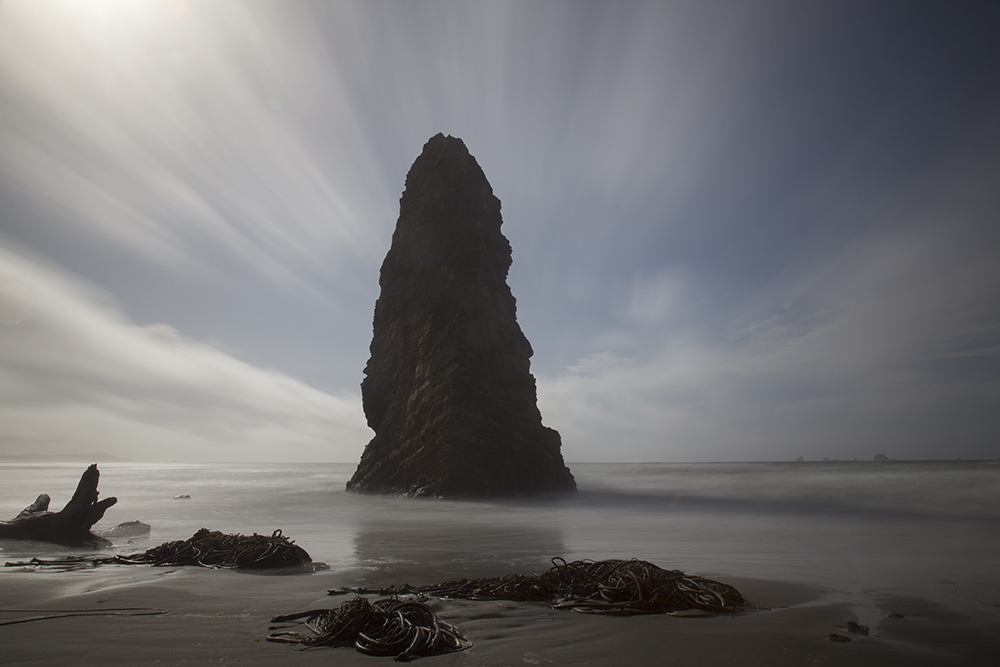
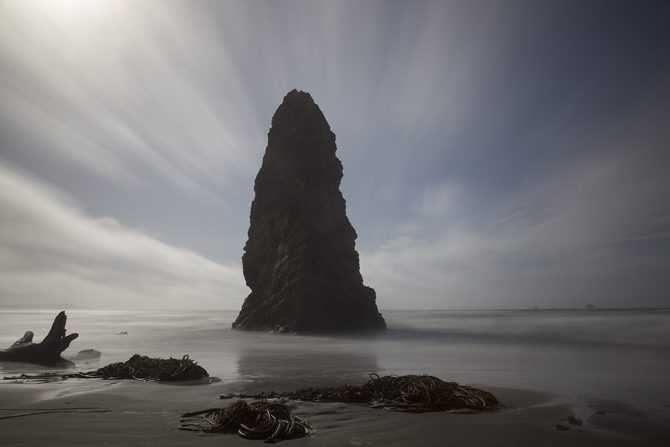
Monolith No. 78 – Before
I’ve had a number of people ask if I’d do some more “before and after” shots. So here are five from my recent Oregon trip.
~~~~~
I had my eye on this Monolith by Cape Blanco for several years, but I had never found an easy way to get down to the beach. On this trip I found one.
At the hour I get there (never early!) the monolith is backlit and so it’s a difficult shot. I was fortunate to have these great delicate clouds that streak well with a long exposure and I envisioned them becoming an important part of the image, if I could deal with the backlight.
The sun was in the upper left corner and it was washing out the clouds and giving me a big flare. I used my hand as a sunshade for the 30 second exposure, properly placing it by watching where my hand’s shadow fell on the lens. I knew that later in Photoshop I’d have to even out the sky, because it was bright on the left and darker on the right.
Then there was the debris on the beach from the last few days of big storms and high tides, but I knew that I could deal with that in post processing.
Monolith No. 78 – After
To deal with the debris I cloned out the tree stump and burned down the foreground to remove the rest. I don’t like anything that distracts from the main subject.
For the sky I burned down the upper left corner to bring out detail in the clouds, then I dodged up the right to balance the sky out. I also used a very small dodging brush to follow the cloud streaks to bring them out more. Adding contrast also helped the clouds stand out against the sky.
The backlighting didn’t hurt me as much as I feared it would. There’s not much shadow detail in the Monolith, but I generally don’t prefer a lot anyway.

Monolith No. 77 – Before
This is one of my favorite images from this trip. I envisioned this Monolith framed by the very dark hills on the sides, the rocks below and the clouds above.
This was a pretty simple image and an easy one…I thought…until I got home and found out that my Vari-ND was doing the dark pattern thing on me. It’s one of the quirks of all variable ND filters, sometimes at wide angles and when the sun angle is just right, you get these weird dark patterns across the image. And here’s a heads up: the cheaper the variable ND filter the more it will do this. That’s why I use the Singh-Ray Vari-ND, it happens much less frequently and when it does, there are a couple of workarounds.
If I had noticed the patterning in the field I could have switched lens and probably have avoided it. This was shot with my 24-105 at 24 mm, which is where the problem can happen, when you’re shooting at the wide end of your lens. If I had switched to the 16-35 and used 24 mm the pattern probably would have gone away, because 24 mm is mid focal length for that lens. And of course another option would have been to simply switch to a fixed ND filter for this shot.
This image also had some vignetting in the corners and I didn’t like how the clouds were thin on the right side of the image.
You might notice that I underexpose my images, usually by about 1 stop. I do this for a couple of reasons. First, I like the look of a dark image with pronounced highlights. Second, it makes it easier to deal with the wide dynamic range in these types of scenes where the sky is important to the image. If I had opened up another stop, that sky would have easily washed out and I’d have lost the cloud detail. Shadow detail is not very important to my images, so underexposing works for me.
Monolith No. 77 – After
I fixed the dark pattern in the sky with vey some careful and slow dodging (it’s easy for a sky to look blotchy if you use a small or hard brush or you work too quickly) I’m typically dodging and burning between 1-3% strength and for skies I’m generally using 1%. I used the clone tool to fix the vignetting and I also cloned in some clouds from the left to the right for a more balanced look.
I also used dodging and burning to bring out the water detail. I call it local contrast enhancement when I go back and forth between burning and dodging to increase the contrast in just one area.
I was happy with how this image turned out, especially after finding out about the dark pattern in the sky.
Something I noticed in the image above: there’s a thin highlight separating the sky from the monolith. I went back to the original TIFF and it’s not there, but it appears when I convert it to a JPEG for the web. I’ll have to do some work to figure out what that is and how to fix it.
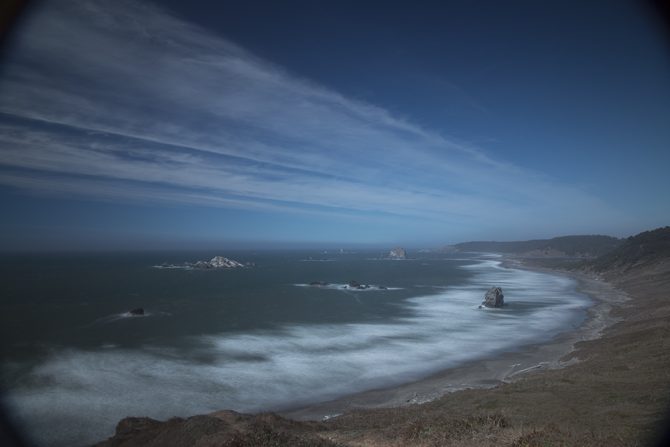
Cape Blanco – Before
People are naturally drawn to lighthouses, as are photographers. But the lighthouse shot is soooooo overdone that I almost didn’t create this one. But I thought I’d see if I could put my twist on it. I love to put the subject small in a large frame and then added a long exposure for a bit of movement. I underexposed and used a polarizer because I wanted black skies.
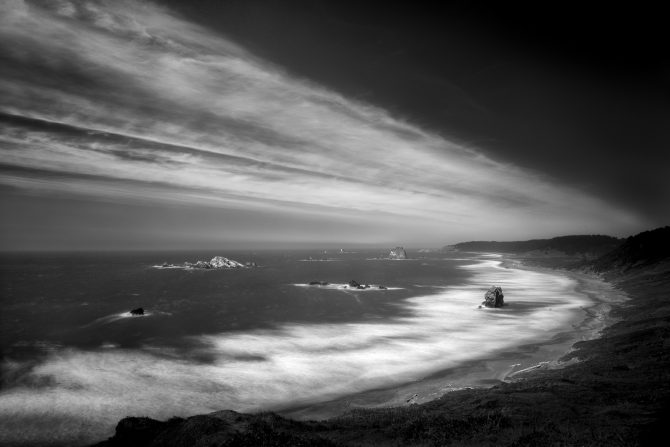
Cape Blanco – After
In the final image, I further isolated the lighthouse by burning down the foreground and the sky. Looking at this image now, a few weeks after I last worked on it, I think I’ll remove those trees on the far right because I find them distracting.

This illustrates how I work to refine an image. I’ll let it sit for a few weeks and then look at it with fresher eyes. I’ll then perhaps modify it again and then put it to bed for a few weeks more before I look at it again.
Now that I’ve removed those trees, I’ll come back in a week to see if I want to keep this change or not.
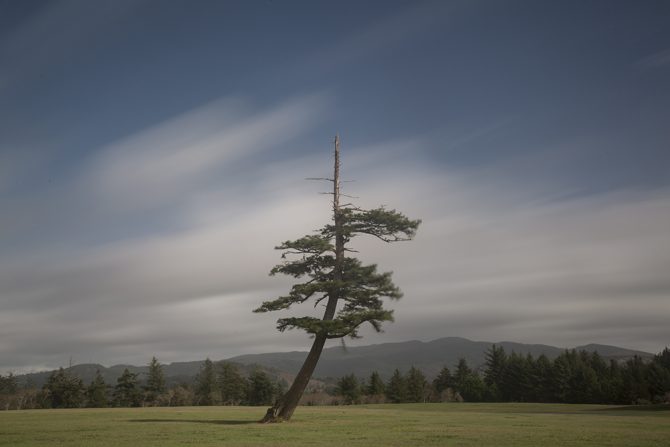
Isolated No. 7 – Before
I was driving on the road to Cape Blanco when this tree just jumped out at me! I love centered images and struggled if I should center the tree where it hits the ground or the upright of the tree. Centering the upright portion of the tree looked more centered and that’s what I went with.
It was a windy and hazy day which made the shot a little challenging. I took about 20 long exposures trying to get the clouds just right and ended up using this one. I didn’t underexpose as I usually do, because I didn’t want to lose the tree detail. It was still a processing challenge and I started over 4 times before I got it right.


Isolated No. 7 – After
Again, I did a lot of dodging and burning on this image. Many people feel that they can do this with a mouse, but I certain cannot! I use a pen and tablet and the control is so much better than with a mouse. I never like to be adamant, but you cannot do what I do with a mouse. Period.
I got rid of the shadow of the tree, that bothered me for some reason, and left a highlight around the tree. I darkened the sky and left it bright behind the tree. As I look at the image today, I think that I may go back and open up the trees a bit on the right side.
As I make decisions about my images, it reminds me of how I’ve seen some others make those decisions. They will show the image to someone and say: What do you think I should do to this image? I am very opposed to that approach, I think one should have a Vision and not adulterate it with someone else’s opinion.
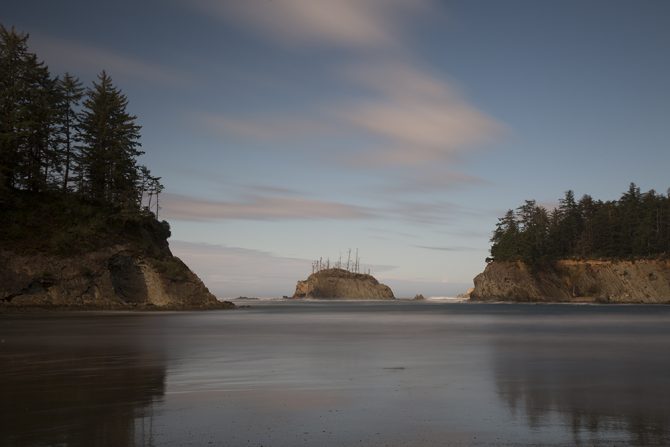
Isolated No. 6 – Before
I was lucky on this trip to have constantly changing weather conditions. Some days it was raining hard, others were sunny and others were constantly changing as on this day. The sun was coming and going and what I was trying to get was the sun hitting the island and the land left and right bits of land in shadow.
I was here for several hours trying to get the clouds and lighting just right. Sometimes the clouds were perfect, but not the foreground. At other times I’d get the shadowing how I wanted it but the clouds were no good.
I didn’t get exactly what I wanted in the shot, but I was confident that I’d be able to create the effect I was looking for in post processing.
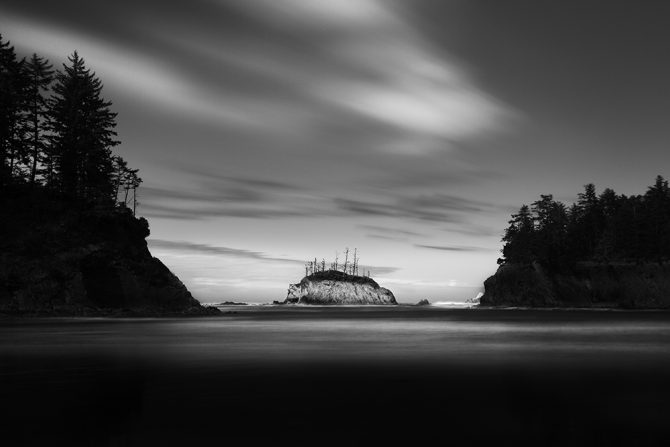
Isolated No. 6 – After
I burned the land down on the left and right to put the focus on the island. Then I dodged up the island to make it brighter. Then I went to work on the clouds, lightening the upper ones and darkening the smaller ones just above the island. Then I darkened the foreground to hide the detail and to bring the eye to the island.
~~~~~
So after seeing these “before and after” shots, I hope that you’ll not conclude that you need to learn more about Photoshop. It is not my intent to focus on post processing as the key to an image because that is exactly what I don’t believe.
Instead my approach is to have a Vision of the image and then let that drive the processing. When you have Vision, your processing then has purpose: to bring the image into compliance with your Vision.
And armed with that Vision, you don’t need to ask others what to do with your image, you already know how it’s going to look in your head!
Cole
October 31, 2014
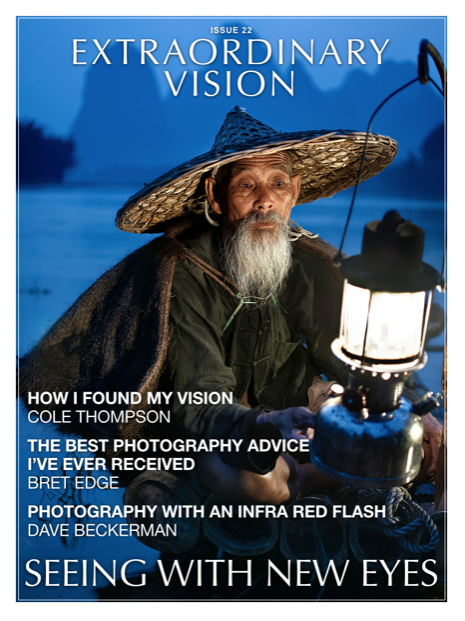
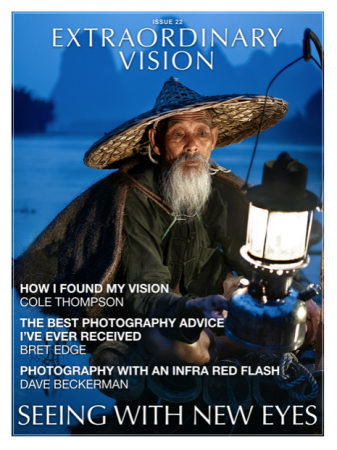
I’m so happy to learn there’s a new magazine out about Vision! It’s great that more and more people are focusing on Vision and less and less about equipment.
I know about this publication because they asked to publish my blog post on “How I Found My Vision.” They did a wonderful job with the article and even gave me a full page ad!
It’s a free publication and here’s where you can find it for Apple and Android:
Also, here is another new image from my Oregon Coast trip, one I created just for fun:
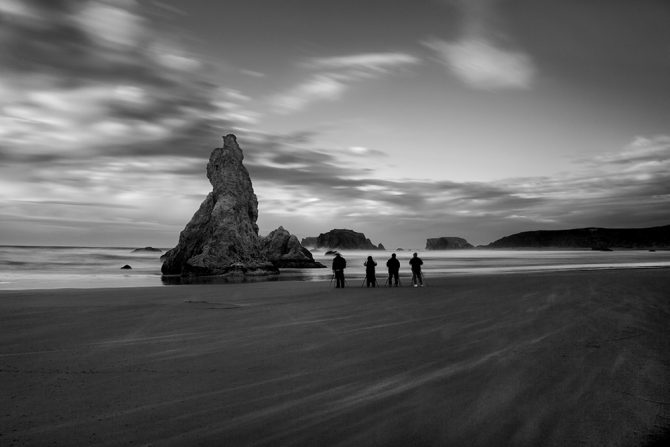
See No Evil, Hear No Evil, Speak No Evil…and Photograph No Evil
August 22, 2014
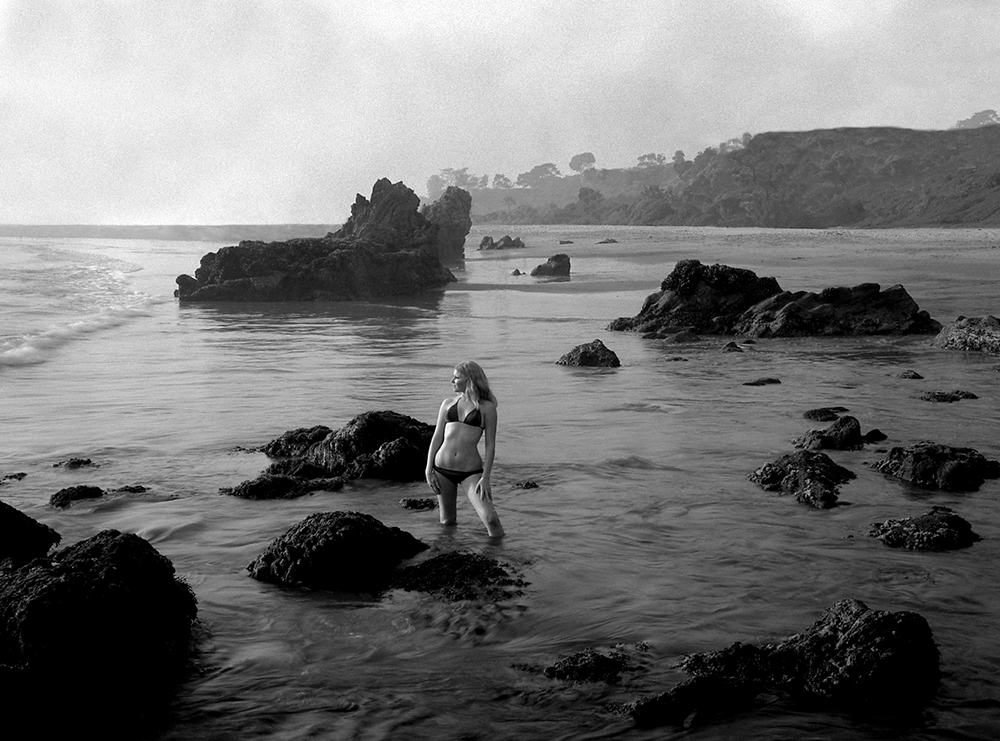
Mary, 1971 – This is my friend from school, Mary Doyle, at Corona Del Mar in California. I created this image with one of my favorite cameras from my youth, a mini-Speed Graphic with a 220 roll back.
1. A wonderful childhood. Beginning at age 14 and for the next several years, photography became my life and I spent every moment either photographing, working in my darkroom or reading about photography.
I have such wonderful memories of those long days working in the darkroom, experimenting and the thrill of discovery.
Two Hippies, 1970 – This was created at my high school, Loara in Anaheim, CA. This was created at the height of the hippy movement, which along with the drug scene was very much alive at my high school.
2. Balance. I chose not to pursue a career in photography for fear I would lose my passion for it, and instead went into business. Unfortunately, due to the demands of family and job I did not pick up the camera for the next 30 years.
My business life was all about numbers, logic and rational decision making, and with no creative outlets my life became lopsided. It was not until I returned to photography in 2004 that I realized how out of balance my life had become.
Photography and the creative process helped bring balance back into my life.
Wooden Indian, 1971 – I worked at Disneyland and this image was created on Main Street. This statue is still standing there today and every time I see it, it conjures up great memories of my youth, photography and working at Disneyland. Ironically I now work in downtown Fort Collins, the downtown that inspired Disney’s Main Street.
3. The Ability to see. Photography has helped me to see beauty in the ordinary and find uniqueness in the common. That makes every location, exotic or not, exciting.
Old Shoes, 1971 – This is a shoe locker at my High School. I had just moved to Anaheim from Rochester, NY and being new, my eyes were fresh and saw everything for the first time. It was a very productive two years because of the encouragement of a dear friend and mentor, John Holland.
4. Vision. Through photography I found my Vision, or my unique way of seeing the world. What I see through my Vision is much different than what I see with my eyes.
My Vision is what fuels my creative process.
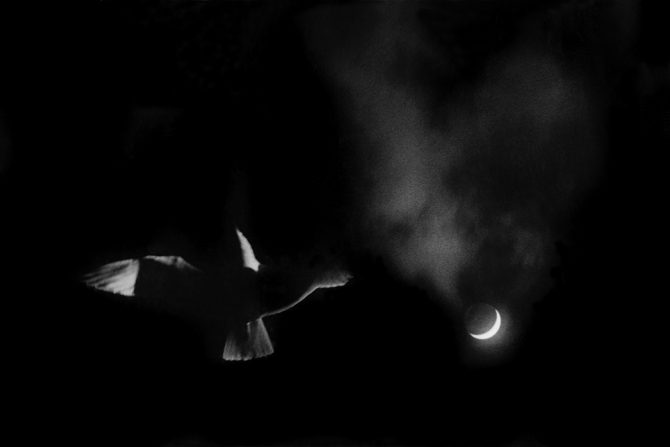
5. Confidence. Finding my Vision and learning to follow it taught me that I didn’t need another persons approval to feel good about my work or myself as an artist.
I’ve learned that if I love my work, that is enough.
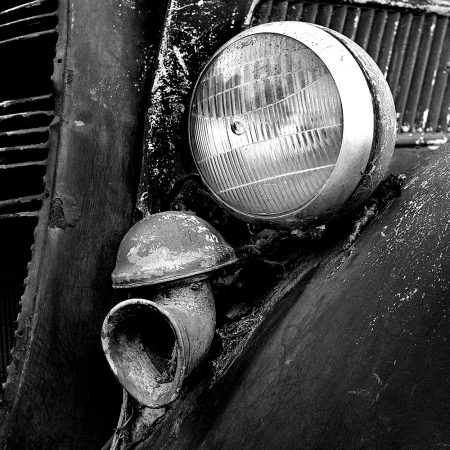
Headlamp, 1970 – This old truck sat in a field across from my High School in Anaheim. I consider this my Edward Weston period, a time when I was mesmerized with his work and tried to copy it.
I thought about adding a sixth item: Purpose. But as I thought about it, I realized that photography is not my purpose in life.
Rather, photography makes my life better and that helps me to fulfill my real purpose in life.
Cole
P.S. The images in this post were created when I was 14-17 years old. These images are like a time machine, transporting me back to those wonderful days when I was young and always had a camera around my neck.
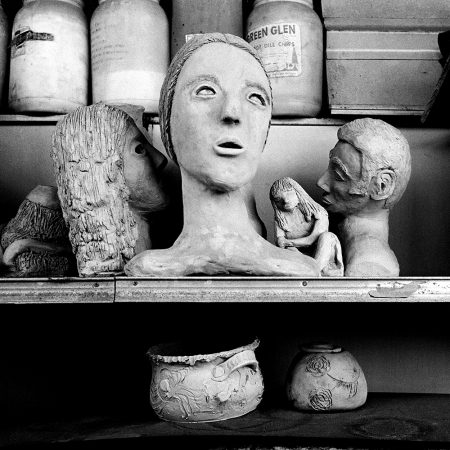
Clay Figure, 1971 – Student projects at my high school.
Artist, 1970 – This portrait artist worked at the Disneyland Hotel shops.
Old Building, 1971 – An old farm shed in Anaheim.
Egg in Glass, 1968 – I was 14 and I had purchased a used Pony 828 camera. I removed the lens mount so that I could focus more closely, and using a ground glass on the film plane, composed this image. I tell people that this was my first “fine art” photograph!
Thousand Steps No. 2 – This was photographed at 1000 steps in Laguna Beach, CA. Many, many fond memories were made here.

The Fox – Downtown Anaheim, where I spent many hours visiting Val and Vic’s Camera Store and photographing.

